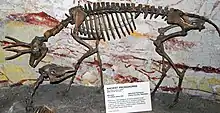| Merycodus Temporal range: Miocene | |
|---|---|
 | |
| Male and female M. warreni | |
| Scientific classification | |
| Domain: | Eukaryota |
| Kingdom: | Animalia |
| Phylum: | Chordata |
| Class: | Mammalia |
| Order: | Artiodactyla |
| Family: | Antilocapridae |
| Subfamily: | †Merycodontinae |
| Genus: | †Merycodus Leidy, 1854 |
| Species | |
| |
| Synonyms | |
|
Meryceros | |
Merycodus is an extinct genus of the artiodactyl family Antilocapridae.[1] Fossils of this genus have been found in the Santa Fe Group of New Mexico.[2]
Taxonomy
Merycodus has had a confusing taxonomic history. The closely related Meryceros and Submeryceros are generally regarded as synonymous with Merycodus.[3][4] One described species known as Merycodus grandis has now been reclassified as a species of Prosynthetoceras.[5] Another former species, M. furcatus is now placed in Cosoryx.
Description

M. cf. nectatus
Merycodus had relatively short horn shafts with tines of nearly equal size that were about as long as the shaft. Species traditionally included in Meryceros had horns that were generally larger and more laterally compressed.[3]
References
- ↑ "Archived copy" (PDF). Archived from the original (PDF) on 2012-09-19. Retrieved 2011-09-05.
{{cite web}}: CS1 maint: archived copy as title (link) - ↑ Galusha, Ted; Blick, John C. (1971). "Stratigraphy of the Santa Fe Group, New Mexico" (PDF). Bulletin of the American Museum of Natural History. 144 (1). Retrieved 13 May 2020.
- 1 2 Janis, Kathleen M. (1998). Evolution of Tertiary Mammals of North America: Volume 1, Terrestrial Carnivores, Ungulates, and Ungulate Like Mammals. Cambridge University Press. p. 496.
- ↑ Prothero, Donald R. (2007). The Evolution of Artiodactyls. Johns Hopkins University Press. p. 232. ISBN 9780801887352.
- ↑ The Texas Journal of Science: Volume 19. Texas Academy of Science. 1967.
Wikimedia Commons has media related to Merycodus.
This article is issued from Wikipedia. The text is licensed under Creative Commons - Attribution - Sharealike. Additional terms may apply for the media files.